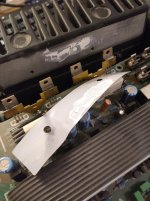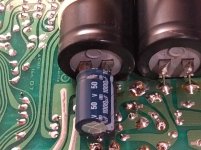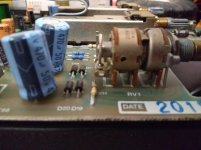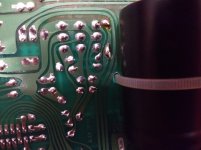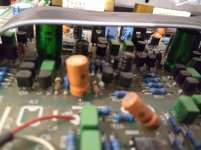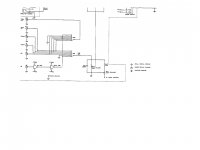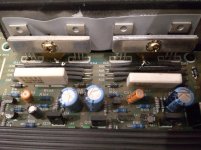They may well be OK but it is something I can't guarantee.
They are a much higher specified device in terms of speed/power/voltage/safe operating area (all of which doesn't necessarily mean better for your intended use).
All you can do is try them. Use the bulb tester initially and confirm that the bias sets up OK and doesn't suddenly jump as you adjust (which can be a sign of oscillation).
They are a much higher specified device in terms of speed/power/voltage/safe operating area (all of which doesn't necessarily mean better for your intended use).
All you can do is try them. Use the bulb tester initially and confirm that the bias sets up OK and doesn't suddenly jump as you adjust (which can be a sign of oscillation).
Had this lying around for years!!
So you have the correct mounting kits and washers.
Try 'em
How many times do we have to repeat that the originals are switching transistors, and so should the replacements be. It seems you either haven't understood a word or are going out of of your way to be contrary on all advice so far, so why ask us for help?
I've already specifically advised against ancient 3055 type plastic variants like MJE3055T which are slugs, ancient industrial GP power transistors that scarcely make the grade as a DC amplifier or regulator. 13009 types have already been suggested and by others too as suitable switching transistors. Please, heed the advice given before you waste more money and time.
The factory could not have fitted newer parts like that additional cap. It's probably there as Mr Fixit's quick way of augmenting or patching over a duff cap. with all he had on hand. If there was a power supply buzzing noise, that's the cheap and nasty way to make it disappear for a while longer or at least until the unit was sold.
It seems as if that's a cast heatsink from a Cyrus 2 in your pic. and as Chris recommended, the surface needs to be smoothed and perfectly flat for reliable operation with such small power transistors, where heat transfer is already marginal. If you use thermal transfer grade silicone washers or sheet instead, you can expect more failures unless you keep the maximum power level down. How you do that is beyond expectations for any normal user but if I said to polite volume levels, perhaps that has a clear meaning?
If this really is a Cyrus 1, it's likely among the 3 versions that were produced, that there is no effective protection from shorts or overload on this one so you do need to take power restrictions seriously, unlike modern amplifiers with multiple nanny-like protection and monitoring features to keep consumers safe from themselves.
Lastly, don't forget Mooly's warning on using a dim bulb tester if firing up after repairs. Unless you're an expert and really know what you're doing, its just asking for a repeat failure if you don't build and use it - plain and simple
I've already specifically advised against ancient 3055 type plastic variants like MJE3055T which are slugs, ancient industrial GP power transistors that scarcely make the grade as a DC amplifier or regulator. 13009 types have already been suggested and by others too as suitable switching transistors. Please, heed the advice given before you waste more money and time.
The factory could not have fitted newer parts like that additional cap. It's probably there as Mr Fixit's quick way of augmenting or patching over a duff cap. with all he had on hand. If there was a power supply buzzing noise, that's the cheap and nasty way to make it disappear for a while longer or at least until the unit was sold.
It seems as if that's a cast heatsink from a Cyrus 2 in your pic. and as Chris recommended, the surface needs to be smoothed and perfectly flat for reliable operation with such small power transistors, where heat transfer is already marginal. If you use thermal transfer grade silicone washers or sheet instead, you can expect more failures unless you keep the maximum power level down. How you do that is beyond expectations for any normal user but if I said to polite volume levels, perhaps that has a clear meaning?
If this really is a Cyrus 1, it's likely among the 3 versions that were produced, that there is no effective protection from shorts or overload on this one so you do need to take power restrictions seriously, unlike modern amplifiers with multiple nanny-like protection and monitoring features to keep consumers safe from themselves.
Lastly, don't forget Mooly's warning on using a dim bulb tester if firing up after repairs. Unless you're an expert and really know what you're doing, its just asking for a repeat failure if you don't build and use it - plain and simple
Hi dj_holmes,
Stick with the parts you ordered.
Nothing has lower distortion unless accompanied with numbers along with a description of how the work was done. That includes a ton of variables in other parts of the circuit. So claims of a lower distortion transistor than another are tenuous at best. Completely unhelpful without all the details. Matching the gain of the PNP device to the NPN will lower distortion for one. In a multi-device output stage (more than 1 of each polarity) the like devices should be matched (not for current sharing, emitter resistors force that at higher currents) for low distortion. That is something On-Semi / Motorola proved in their labs (up to a 20 dB improvement!), and I have also proved that on my bench. You have to hold all variables constant except the matching of the outputs to prove this. It is time consuming. The results are audible, and that is something I proved in my shop 30 years ago now. Tested again 2 years ago again and confirmed those results again.
The match on the diff pair also has a large effect on distortion performance. Not surprising really. Proved that in my early 20's and again reconfirmed those results every decade or so.
You are lucky that nothing else is actually blown, but I would highly recommend you replace the drivers too. Even if they did blow, they were stressed beyond their ratings when the outputs left the planet. This can cause distortion, unsteady bias and / or later failure. It really isn't worth it to leave them in.
The plastic pad you found is a thermal transfer insulator. I hate them, the grease was probably to stick it in place long enough to screw things together. Now would be a good time to either use mica and grease, or one of the newer thermal pads. Either option really improves thermal performance. While you have this apart, take a fine, flat file and carefully make that mounting surface smooth. The way it is is too rough. THeir later amplifiers are even worse. Even under warranty I would spend the time to file them flat. This is the only criticism I have for Cyrus. I have a pair of Mono-X amplifiers that I got new. They will be coming apart soon for detail work, and making the mounting surfaces flat is #1 on the to do list. Getting rid of those darned BFA connectors for the speakers is #2.
-Chris
Stick with the parts you ordered.
Nothing has lower distortion unless accompanied with numbers along with a description of how the work was done. That includes a ton of variables in other parts of the circuit. So claims of a lower distortion transistor than another are tenuous at best. Completely unhelpful without all the details. Matching the gain of the PNP device to the NPN will lower distortion for one. In a multi-device output stage (more than 1 of each polarity) the like devices should be matched (not for current sharing, emitter resistors force that at higher currents) for low distortion. That is something On-Semi / Motorola proved in their labs (up to a 20 dB improvement!), and I have also proved that on my bench. You have to hold all variables constant except the matching of the outputs to prove this. It is time consuming. The results are audible, and that is something I proved in my shop 30 years ago now. Tested again 2 years ago again and confirmed those results again.
The match on the diff pair also has a large effect on distortion performance. Not surprising really. Proved that in my early 20's and again reconfirmed those results every decade or so.
You are lucky that nothing else is actually blown, but I would highly recommend you replace the drivers too. Even if they did blow, they were stressed beyond their ratings when the outputs left the planet. This can cause distortion, unsteady bias and / or later failure. It really isn't worth it to leave them in.
The plastic pad you found is a thermal transfer insulator. I hate them, the grease was probably to stick it in place long enough to screw things together. Now would be a good time to either use mica and grease, or one of the newer thermal pads. Either option really improves thermal performance. While you have this apart, take a fine, flat file and carefully make that mounting surface smooth. The way it is is too rough. THeir later amplifiers are even worse. Even under warranty I would spend the time to file them flat. This is the only criticism I have for Cyrus. I have a pair of Mono-X amplifiers that I got new. They will be coming apart soon for detail work, and making the mounting surfaces flat is #1 on the to do list. Getting rid of those darned BFA connectors for the speakers is #2.
-Chris
Hi Ian,
I still use a variac on repaired items or for initial checkout.
The output transistors aren't that critical as long as they aren't a lot faster. The later Cyrus products went to normal output transistors, and when I couldn't get stock on the factory outputs (or suggested subs) I had to use normal audio output transistors. The distortion did not suffer in these cases, so it is possible to use normal audio transistors in these output sections without ill effects. If you can use the originals, I agree they ought to be used. Over here in Canada, the supply of original outputs has been very spotty. I might still have a couple from the last time I was able to get them. Maybe. Not something to be overly concerned about from what I have seen.
-Chris
I still use a variac on repaired items or for initial checkout.
The output transistors aren't that critical as long as they aren't a lot faster. The later Cyrus products went to normal output transistors, and when I couldn't get stock on the factory outputs (or suggested subs) I had to use normal audio output transistors. The distortion did not suffer in these cases, so it is possible to use normal audio transistors in these output sections without ill effects. If you can use the originals, I agree they ought to be used. Over here in Canada, the supply of original outputs has been very spotty. I might still have a couple from the last time I was able to get them. Maybe. Not something to be overly concerned about from what I have seen.
-Chris
Thanks guys. Didn't want to upset anyone but Mooly has helped me out numerous times before so I tend to follow his advice.
I didn't even know about the whole matching of gain thing. I still don't kind of understand it but it makes sense, so its not just a case of what is the best output transistors!! Thanks Chris
Ian I did want to try the 13009 but the 3055 apparently is closer to original spec!?! And I guess original is best given the valid argument Chris made. Its show how little I know and how really complex getting "better" actually is!
The drive (driver?) transistors measure really good above 600 (is that volts or ohms?) on each leg and are original MJE253 and MJE243. I read that the BD transistors can be used. I actually accidentally purchased a few of these not sure if I have 2 pairs and I rather keep original MJE in place but swapping them out could be an option.
Another complex question, the limited edition version of the Cyrus has "blue alps" for higher quality sound with balance taken out. I had a look at both the SM and the amplifier itself I can see it can physically be fitted from website measurements. Is it just a simple of removing the old and fitting the new?
Notice the green muse caps in 3rd pic? Its factory fitted the solder is consistent with the rest! The Cyrus is the latest model with the toggle switch but never seen that cap in all the internet pictures!
I didn't even know about the whole matching of gain thing. I still don't kind of understand it but it makes sense, so its not just a case of what is the best output transistors!! Thanks Chris
Ian I did want to try the 13009 but the 3055 apparently is closer to original spec!?! And I guess original is best given the valid argument Chris made. Its show how little I know and how really complex getting "better" actually is!
The drive (driver?) transistors measure really good above 600 (is that volts or ohms?) on each leg and are original MJE253 and MJE243. I read that the BD transistors can be used. I actually accidentally purchased a few of these not sure if I have 2 pairs and I rather keep original MJE in place but swapping them out could be an option.
Another complex question, the limited edition version of the Cyrus has "blue alps" for higher quality sound with balance taken out. I had a look at both the SM and the amplifier itself I can see it can physically be fitted from website measurements. Is it just a simple of removing the old and fitting the new?
Notice the green muse caps in 3rd pic? Its factory fitted the solder is consistent with the rest! The Cyrus is the latest model with the toggle switch but never seen that cap in all the internet pictures!
Attachments
I would leave the original controls in it. I highly doubt you will hear a difference unless the existing one is worn out. A balance control is always nice to have. If one exists, I would leave that in there also.
-Chris
The Alps is more "high end" and only costs £6 from China. The original looks cheap and gets dirty quite easily. The problem is both the volume and balance is in one!?! If the balance can be fixed to stereo then I can easily fit the new Alps. So any advice please.
Hi dj_holmes,
Get the amplifier running before doing anything else to it. Just because the existing control has openings doesn't mean it is a bad or cheap control. I have seen the new controls like the one you are talking about completely worn out. Even today the original controls tend to be fine after a light cleaning. Do not pump a lot of cleaning fluid into any control as it will remove the lubricants inside the control that protect the resistive element and the bushings. Only ever use the minimum amount of cleaner to get the job done. Chemicals are tools, use them appropriately.
Again, fix the amp first. Only change one thing about any circuit at a time so you can troubleshoot easily when a problem occurs. Once you have it running properly you can do other things. But don't use a $6 control for one that is normally $20 or more.
-Chris
The Alps is more "high end" and only costs £6 from China. The original looks cheap and gets dirty quite easily. The problem is both the volume and balance is in one!?! If the balance can be fixed to stereo then I can easily fit the new Alps. So any advice please
The cheap controls are probably a knock-off given their normal price. Under those conditions you will install an inferior control if you change it.I would leave the original controls in it. I highly doubt you will hear a difference unless the existing one is worn out. A balance control is always nice to have.
Get the amplifier running before doing anything else to it. Just because the existing control has openings doesn't mean it is a bad or cheap control. I have seen the new controls like the one you are talking about completely worn out. Even today the original controls tend to be fine after a light cleaning. Do not pump a lot of cleaning fluid into any control as it will remove the lubricants inside the control that protect the resistive element and the bushings. Only ever use the minimum amount of cleaner to get the job done. Chemicals are tools, use them appropriately.
Again, fix the amp first. Only change one thing about any circuit at a time so you can troubleshoot easily when a problem occurs. Once you have it running properly you can do other things. But don't use a $6 control for one that is normally $20 or more.
-Chris
The Alps is suppose to be a lot better! Also its genuine even for £6! I suppose its like $10.
I added the schematic cant it just be bypassed or moved? Never seen that type of setup before. It doesn't hurt to consider it!
Also I should be getting the parts tomorrow
I added the schematic cant it just be bypassed or moved? Never seen that type of setup before. It doesn't hurt to consider it!
Also I should be getting the parts tomorrow
Attachments
Hi,
Read my previous posts again please. One change at a time only. The new control may or may not be the real thing. Wishful thinking does not make it so.
So fix your amplifier and set it up before doing anything else to it. Listen to it playing until you are familiar with it (like, about a week or so). After that you can chop it up or whatever you want to do to it. At least you will know what one used to sound like. Making too many changes at one time isn't wise, especially for you and this amplifier.
The new control will still be there after a week, so no rush.
-Chris
Read my previous posts again please. One change at a time only. The new control may or may not be the real thing. Wishful thinking does not make it so.
So fix your amplifier and set it up before doing anything else to it. Listen to it playing until you are familiar with it (like, about a week or so). After that you can chop it up or whatever you want to do to it. At least you will know what one used to sound like. Making too many changes at one time isn't wise, especially for you and this amplifier.
The new control will still be there after a week, so no rush.
-Chris
Success! Output transistors replaced and no blown fuses!
Tested quick power on with speakers an input works fine.
Tested bias and in a few minutes it already reached 20mv and rising. I stopped it there just in case it blew. On the SM manual it says if its too high to place a 180r resistors between the two terminals. Should I try to find a close value and try it?
Tested quick power on with speakers an input works fine.
Tested bias and in a few minutes it already reached 20mv and rising. I stopped it there just in case it blew. On the SM manual it says if its too high to place a 180r resistors between the two terminals. Should I try to find a close value and try it?
Attachments
- Status
- This old topic is closed. If you want to reopen this topic, contact a moderator using the "Report Post" button.
- Home
- Amplifiers
- Solid State
- What makes a good output transistor for Cyrus One
